What is really in our cleaning products? Who is most affected? What habits can we change to reduce our exposures to harmful chemicals? These questions and more are answered by the LUCIR study, conducted by youth in Salinas, CA, a predominantly Latinx farmworker community, in collaboration with researchers from UC Berkeley and La Clinica de Salud del Valle de Salinas.
About Us
James Earl Schier Nolan: Can you tell me about why you wanted to engage in this project? What motivated you the most?
Andrea Alonzo: Ever since I can remember, our families have taught us how to care for ourselves. One of the most important lessons is cleanliness. We clean when we wake up, before we sleep, and when we are expecting guests. Many of us clean our homes every day to the point where it can be considered necessary in our lives. House cleaning has become second nature for us, and we’re sure many Latinx households can relate.
Edwin Rodriguez: Now it is our turn to give back to the community that raised us. Andrea and I, together with a special cohort of other high school-aged environmental health leaders in Salinas, conducted a study to determine our community’s exposures to potentially harmful chemicals in the cleaning products they use.
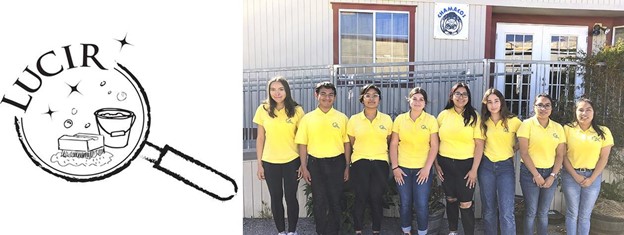
The youth council in the summer of 2019 (right)
What is LUCIR?
JESN: What was the focus of the LUCIR Study? Why is it called “LUCIR”?
ER: The LUCIR Study, or Lifting Up Communities by Intervening with Research, is a study we conducted in our small city of Salinas. The goals of the study are to investigate Latina women’s exposures to chemicals in cleaning products they regularly use, and to determine whether we can reduce these exposures by using green cleaning products instead.
JESN: Why focus on Latina women specifically?
AA: Latina women may face higher exposures as more than 80% of professional household cleaners in California are Latina. (CBCRP).
ER: So, we recruited 50 Latina women in Salinas and conducted home visits to monitor the air in their homes while they cleaned. During our first study visit, we asked them to use their regular products and go about their normal cleaning routines using the products they typically would use. Participants wore scientific air monitoring backpacks with specialized filters designed to capture chemicals from the air in the women’s breathing zones.
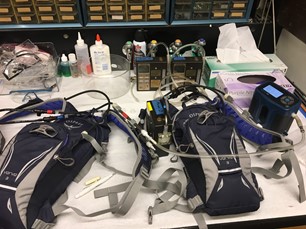
JESN: There are lots of variables that might affect the exposure data collected. How did you track these?
AA: We inventoried and photographed the products participants used, measuring their weights before and after use, and recorded how participants used them and what habits they displayed while cleaning, such as using proper ventilation. After collecting data this first visit, we gave them a full set of locally purchased and affordable green cleaning alternatives, asked them to use those for a whole week, and then we returned and collected a new set of data while these green products were being used.
JESN: This is clearly a unique study. Who did you turn to for data processing?
ER: Samples were analyzed at the Lawrence Berkeley National Laboratory to see what chemicals of concern were in the air the women were breathing while they used conventional cleaning products, and to note the extent to which these exposures decreased by switching to green cleaning products.

The Results
JESN: What did you end up finding?
AA: Combined, participants used 205 different cleaning products. Though these products may contain hundreds or even thousands of chemicals in total, we limited our analysis to focus specifically on potential carcinogens and hormone disruptors, chemicals that we worry might impact women’s health.
JESN: What did you observe when participants switched to green cleaning products?
ER: When participants switched from their conventional cleaning products to green cleaning products, the levels of 17 different harmful chemicals decreased. Some key chemicals of concern that decreased are acetaldehyde (down 38%), 1,4-dioxane (down 49%) and chloroform (down 86%). However, levels of fragrance compounds were high in both visits and some fragrance levels were even higher with the green products.
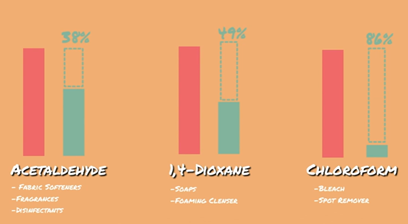
JESN: It’s encouraging to see so many chemicals of concern decreasing just by switching to green cleaning products. Based on the findings, what advice would you give to the general public?
AA: We highly recommend switching from conventional products to green products, and we encourage you to choose unscented products as much as possible. We also recommend opening doors and windows to improve ventilation while cleaning, and using microfiber cloths, as they can be more effective in wiping dirt and germs away.
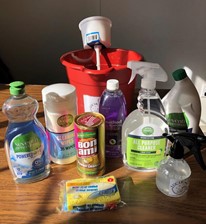
What Does This Mean for the Latinx Community?
JESN: What are some of the implications of this study for the Latinx community?
ER: Salinas is a city filled with hardworking families, primarily of Latinx origin. In Latinx culture, house cleaning is an extremely common task in everyday life and is usually done by women. Since domestic work is also a common job for Latina women, Latina women are at increased risk of exposure to the chemicals in cleaning products and the potential long term health effects that go with them. The LUCIR study was conducted in Salinas, with 100% of the participants being Latina women. So we specifically tested the exposure of Latina women in our community, and the results were astonishing to me.
AA: These madres, hijas, and tias are facing exposure to chemicals from their cleaning products, products they use every day. But these exposures can easily be reduced by being more conscious of the products that we buy. It is concerning to learn that exposure to certain chemicals in commonly used cleaning products might put us at an increased risk of health issues.

Our Experience and Spreading Our Message
JESN: Can you tell me more about the process behind the scenes and the next steps? Once you had findings, how did you work to return them to the community?
ER: After the results came back, our team began brainstorming ways to spread our findings. We held meetings biweekly to learn how to actively engage in our community to gain support for our study. We came up with ideas all while learning about advocacy skills, leadership, and policy making. We did mini workshops including elevator pitches and we came up with many possible community outreach projects. We also invited guest speakers to speak to us about how to translate our findings into policy making and how to convey our message clearly in interviews.
AA: Over the summer of 2020, we contracted with a local group called Artists Ink to create animated PSAs to share our findings. We learned how to use programs like Adobe Draw, Audacity, and Adobe Animate to develop and voice our own characters. It was an amazing experience to be able to learn about animation, voice acting, Foley artistry, and storyboarding, all while creating something that will spread an important message to our community. At the end of the summer, with the help of the team at Artists Ink, we successfully created three videos with unique and relatable stories. We want to help inspire a healthier Salinas, and a healthier world for our mothers, aunts, grandmothers, daughters and sisters. Now we need your help to spread our message!
Resources:
- Please view and share our animated public service announcements, available in both English and Spanish
- Click here for more information about the LUCIR Study
- Want to learn even more about how to reduce your exposures to harmful chemicals in cleaning products? Resources like the Environmental Working Group’s Healthy Cleaning Guide can help inform your next cleaning product purchase.
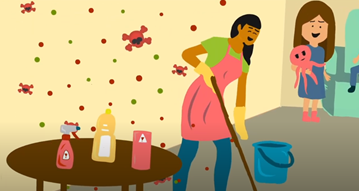
This project was funded by the California Breast Cancer Research Program. Special thanks to Principal Investigator Dr. Kim Harley.

